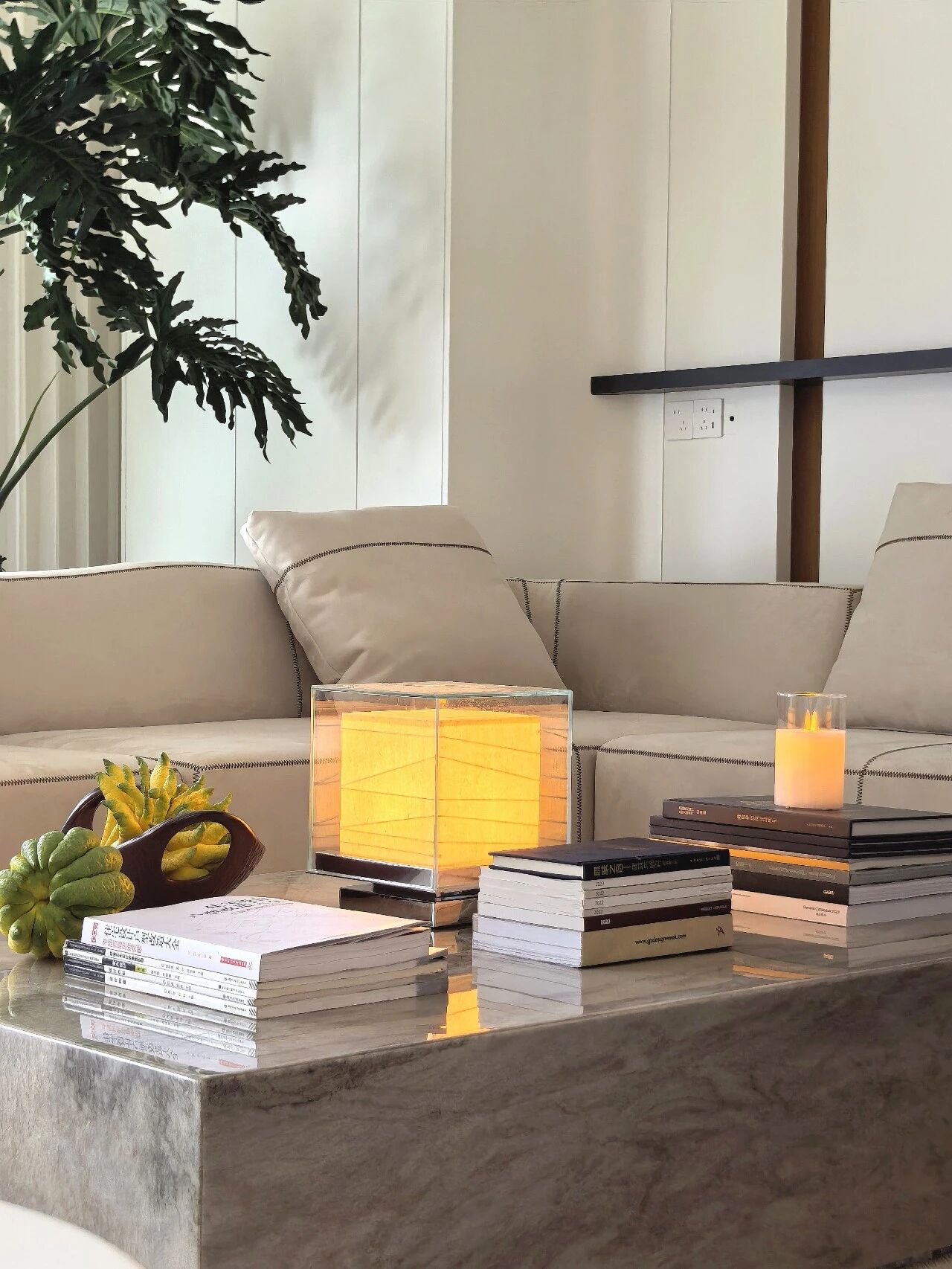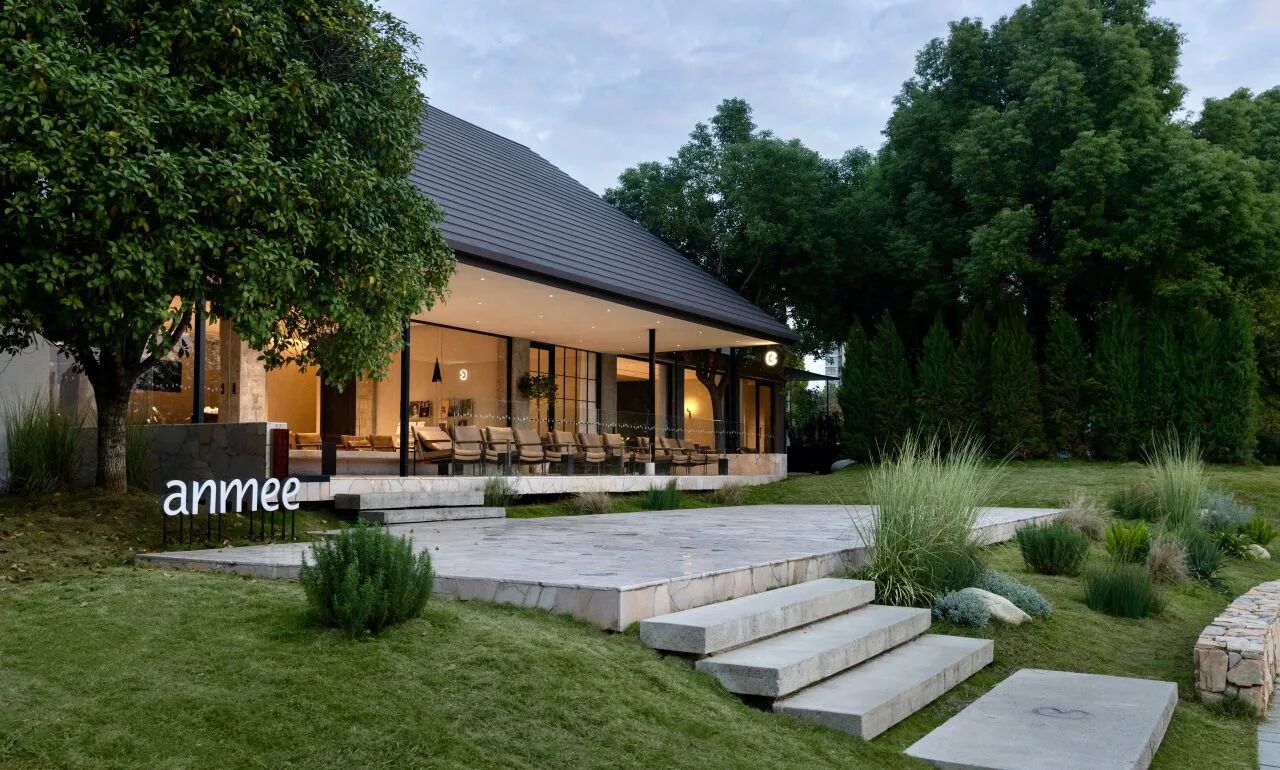An Interview with Italian Design Duo Calvi Brambilla
2019-03-14 14:23
Milan-based design studio Calvi Brambilla is one of those rare partnerships that have effortlessly combined the professional with the personal. Formed in 2006 by Fabio Calvi and Paolo Brambilla, the practice, which combines architecture, interior design and product design, is sustained by their shared love for design as well as each other. The pair has forged a reputation in Italy’s retail design scene by having collaborated with many esteemed brands, designing their showrooms, fair booths, and even some of their products. Recent projects include Zanotta’s fair booth at Milan’s Salone del Mobile which featured graphic walls of colourful motifs and disassembled armchairs on the walls, Antonio Lupi’s Milan showroom whose irregular architectural vaults were inspired by the 16th century Kılıç Ali Paşa baths in Istanbul, and Barovier - Toso’s majestic new Venetian showroom. Taking up an entire three-storey palazzo in Murano, the latter is also one of the Studio’s largest and most dazzling projects to date. Playfully appropriating the architectural language of historic palazzos, filtered through contemporary sense of minimalist elegance and subdued a luxuriance, Calvi Brambilla have designed a series of evocative rooms that literally and figuratively reflect Barovier - Toso’s opulent glass-blown chandeliers, and harmoniously encapsulate both the company’s 700 year-old history and its modern aspirations. Paolo and Fabio recently talked to Yatzer about their studio practice, their recent projects and the challenges in designing for famous design brands. (Answers have been condensed and edited for clarity)
米兰的设计工作室CalviBrambilla是那些与个人毫不费力地结合在一起的罕见的合作伙伴之一。由FabioCalvi和PaoloBrambilla于2006年形成,这种做法结合了建筑、室内设计和产品设计,通过他们对设计和彼此的共同热爱而得以持续。该公司在意大利的零售设计场景中,通过与多家知名品牌合作,设计了他们的展示室、公平的展位,甚至一些产品,在意大利的零售设计场景中赢得了声誉。最近的项目包括Zanotta在米兰的SallonedelMobile上的公平展位,其特征是墙上有彩色图案和拆卸的扶手椅,安东尼奥·卢皮(AntonioLupi)米兰的陈列室,其不规则的建筑金库受到16世纪的KingoleanC.AliPAS的启发,在伊斯坦布尔的一个浴场,以及Barrovier。
Fabio Calvi (right) and Paolo Brambilla (left). Photo by Tommaso Sartori.
法比奥·卡尔维(右)和保罗·布拉比利亚(左)。图片来源于Tommaso Sartori。
Calvi Brambilla apartment. Photo by Denise Bonenti.
卡尔维·布拉比利亚公寓。图片来源于Denise Bonenti。
Calvi Brambilla apartment. Photo by Denise Bonenti.
卡尔维·布拉比利亚公寓。图片来源于Denise Bonenti。
Calvi Brambilla apartment. Photo by Denise Bonenti.
卡尔维·布拉比利亚公寓。图片来源于Denise Bonenti。
Calvi Brambilla apartment. Varaschin, 'Poggiano' coffee table, 2010 and Varaschin, 'Lapis family' indoor furniture collection chair, 2011 by Calvi Brambilla. Photo by Denise Bonenti.
CalviBrambilla公寓。Vargaschin,*Pogiano*咖啡桌,2010和Varaschin,*LapisFamily*室内家具收藏椅,2011年,CalviBrambilla。丹尼斯·邦蒂(DeniseBonenti)的照片。
Calvi Brambilla apartment. Varaschin, 'Poggiano' coffee table, 2010 by Calvi Brambilla. Photo by Denise Bonenti.
CalviBrambilla公寓。Vargaschin,*Pogiano*咖啡桌,2010年,CalviBrambilla。丹尼斯·邦蒂(DeniseBonenti)的照片。
How did your partnership come about? How does your personal relationship affect your professional collaboration? Paolo Brambilla: Fabio used to work on his own, but after just one year he got the chance to concurrently work at Flos [as the company’s art director] so he asked me to help him. The first time I said no, because I was afraid that combining my private life with work could be a mistake. At that time I was working for a big architecture practice, and I wasn’t ready to jump right in yet. The second time he asked me I accepted the bet, and twelve years have passed since then. Being partners in work and life means never having a break, but I think this applies to many creative works. If you had to describe your design aesthetic in a few sentences, what would it be? Who or what are your inspirations? PB: We don’t have a specific style, because our projects are made-to-measure according to the specific needs and style of the client; this allows us to work with many different partners at the same time. However, we are known for two specific features: on the one hand, a certain irony, which is always present, even in the most challenging projects, and on the other hand, our architectural approach to every project, even temporary installations.
你们的合作是怎么来的?你的人际关系如何影响你的专业合作?保罗·布兰比利亚:法比奥曾经独自工作过,但仅仅一年后,他就有机会同时在Flos(作为公司的艺术总监)工作,所以他请求我帮助他。我第一次说不,是因为我害怕把我的私生活和工作结合起来可能是个错误。当时我正在为一家大型的建筑实践公司工作,我还没有准备好跳槽。他第二次问我,我接受了这个赌注,从那时起,十二年过去了。作为工作和生活中的伙伴意味着永不休息,但我认为这也适用于许多创造性的作品。如果你不得不用几句话来描述你的设计美学,它会是什么?你的灵感是谁或什么?PB:我们没有特定的风格,因为我们的项目是根据客户的具体需求和风格来制定的;这允许我们同时与许多不同的合作伙伴一起工作。然而,我们有两个具体的特点:一方面,具有某种讽刺意味,即使在最具挑战性的项目中也是如此;另一方面,我们对每一个项目的建筑方法,甚至是临时安装。
Calvi Brambilla apartment. Varaschin, 'Poggiano' coffee table, 2010 by Calvi Brambilla. Photo by Denise Bonenti.
CalviBrambilla公寓。Vargaschin,*Pogiano*咖啡桌,2010年,CalviBrambilla。丹尼斯·邦蒂(DeniseBonenti)的照片。
Calvi Brambilla apartment. Photo by Denise Bonenti.
卡尔维·布拉比利亚公寓。图片来源于Denise Bonenti。
Calvi Brambilla apartment. Varaschin, 'Knot' side table 2013 by Calvi Brambilla. Photo by Denise Bonenti.
卡尔维·布拉比利亚公寓。瓦拉斯钦,“结”边表,2013年,卡尔维·布拉比利亚。图片来源于Denise Bonenti。
Calvi Brambilla apartment. Photo by Denise Bonenti.
卡尔维·布拉比利亚公寓。图片来源于Denise Bonenti。
Calvi Brambilla apartment. Photo by Denise Bonenti.
卡尔维·布拉比利亚公寓。图片来源于Denise Bonenti。
Calvi Brambilla apartment. Photo by Denise Bonenti.
卡尔维·布拉比利亚公寓。图片来源于Denise Bonenti。
How different are you as designers? How do your resolve any creative differences that arise during the design process? Fabio Calvi: Paolo has a more analytical and rational mind, while I am more intuitive and instinctive. The combination of our two personalities makes us a complete designer. You have excelled in exhibition design with several awards to prove it. How different are these kind of temporary projects from interior and architectural commissions? PB: Probably the main reason why we had some success in the specific field of exhibition design is that we tried to introduce new solutions inspired by the world of architecture and contemporary art. While the approach at the fairs is often strictly commercial, we manage to combine commercial needs with some more unexpected solutions. FC: On the one hand, temporary installations can give great satisfaction to the designer because the ideas come true in a few months. On the other hand, it is regrettable that what remains of such great effort is only a handful of photographs.
你作为设计师有多不同?如何解决在设计过程中出现的创造性差异?法比奥·卡尔维:保罗有更多的分析和理性头脑,而我则更直觉和本能。我们两种性格的结合使我们成为一个完整的设计师。你在展览设计方面表现出色,多次获奖证明了这一点。这些临时项目与内部和建筑委员会有什么不同?PB:也许我们在具体的展览设计领域取得一些成功的主要原因是我们试图引进新的解决方案,这些解决方案受到建筑和当代艺术世界的启发。虽然集市上的方法通常是严格商业化的,但我们设法将商业需求与一些更出乎意料的解决方案结合起来。一方面,临时安装可以给设计师很大的满足感,因为这些想法在几个月内就会实现。另一方面,令人遗憾的是,如此巨大努力所剩下的只是少数几张照片。
Palazzo Barovier - Toso in Murano, Venice. Interior design by Calvi Brambilla. Photo courtesy of Barovier - Toso.
Palazzo Barovier - Toso in Murano, Venice. Interior design by Calvi Brambilla. Photo courtesy of Barovier - Toso.
Palazzo Barovier - Toso in Murano, Venice. Interior design by Calvi Brambilla. Photo courtesy of Barovier - Toso.
Palazzo Barovier - Toso in Murano, Venice. Interior design by Calvi Brambilla. Photo courtesy of Barovier - Toso.
Palazzo Barovier - Toso in Murano, Venice. Interior design by Calvi Brambilla. Photo courtesy of Barovier - Toso.
Palazzo Barovier - Toso in Murano, Venice. Interior design by Calvi Brambilla. Photo courtesy of Barovier - Toso.
How did you approach the renovation of such a historic venue as Murano’s Palazzo Barovier - Toso? How did the idea of monochrome rooms come about? FC: Barovier - Toso is one of the oldest companies in the world, founded in Murano seven centuries ago and registered in the Guinness Book of Records. Designing for such a company is a great responsibility so to avoid being overwhelmed by the weight of the company’s heritage we faced the project with a certain irony. PB: We did not want to make a fictitious reconstruction of a classical style interior, but at the same time we liked the idea of making certain references to the past: the terrazzo floor, the wall panelling and so on. The idea of the monochromatic rooms came to mind because often in the noble residences different halls are distinguished by different colours. We chose white, black, blue and gold because they are the most characteristic colours used for Barovier - Toso products, even though the company offers a very wide range of colours.
你是如何看待穆拉诺的巴罗维耶宫这样一个历史悠久的场地的翻新的?
Palazzo Barovier - Toso in Murano, Venice. Interior design by Calvi Brambilla. Photo courtesy of Barovier - Toso.
Palazzo Barovier - Toso in Murano, Venice. Interior design by Calvi Brambilla. Photo courtesy of Barovier - Toso.
Palazzo Barovier - Toso in Murano, Venice. Interior design by Calvi Brambilla. Photo courtesy of Barovier - Toso.
Palazzo Barovier - Toso in Murano, Venice. Interior design by Calvi Brambilla. Photo courtesy of Barovier - Toso.
Palazzo Barovier - Toso in Murano, Venice. Interior design by Calvi Brambilla. Photo courtesy of Barovier - Toso.
Palazzo Barovier - Toso in Murano, Venice. Interior design by Calvi Brambilla. Photo courtesy of Barovier - Toso.
Palazzo Barovier - Toso in Murano, Venice. Interior design by Calvi Brambilla. Photo courtesy of Barovier - Toso.
Your portfolio includes many showrooms and fair booth for famous design brands. What are the challenges in designing for a brand whose aesthetic is different from yours? FC: For every single company we develop a specific marketing strategy and a unique project; in some way we play a role very similar to a media agency. The exhibition design must always be perfectly consistent with what it contains, or with the brand it represents. Those projects where the author's personal touch prevails could be failures. On the other hand, if the product is not interesting, even though the set design is well done, the result will be weak. You have collaborated with many lighting manufacturers for whom you’ve designed their showrooms and exhibition booths as well as new light fittings. Why are you so fascinated with light? Did your interest originate from Fabio’s work experience as FLOS’ art director? As we mentioned before, we are both obsessed with design and light fittings in particular. Fabio’s collaboration with Flos was the result rather than the root of this passion.
您的投资组合包括许多展厅和著名设计品牌的展位。设计一个与你的品牌不同的品牌的挑战是什么?FC:对于每一家公司,我们都制定了一个具体的营销策略和一个独特的项目;在某种程度上,我们所扮演的角色非常类似于一家媒体机构。展览设计必须始终与其所包含的内容完全一致,或与其所代表的品牌完全一致。那些作者个人接触盛行的项目可能是失败的。另一方面,如果产品不感兴趣,即使成套设计做得很好,结果也会很差。您已经与许多照明制造商合作,您已经为他们设计了展厅和展位,以及新的灯具配件。你为什么对光如此着迷?你的兴趣来自法比奥作为福洛斯艺术总监的工作经历吗?正如我们前面提到的,我们都痴迷于设计,尤其是灯光配件。法比奥与弗洛斯的合作是这种热情的结果,而不是根源。
*Storie. Il design italiano* at La Triennale di Milano, 2018. Exhibition design by Calvi Brambilla. Photo by Gianluca Di Ioia.
意大利设计“,2018年,在米兰的拉特里恩纳莱剧院(La Triennale Di Milano)。展览设计由Calvi Brambilla。图片来源:Gianluca Di Ioia。
*Storie. Il design italiano* at La Triennale di Milano, 2018. Exhibition design by Calvi Brambilla. Photo by Gianluca Di Ioia.
意大利设计“,2018年,在米兰的拉特里恩纳莱剧院(La Triennale Di Milano)。展览设计由Calvi Brambilla。图片来源:Gianluca Di Ioia。
Antoniolupi Showroom in Milano, 2018. Interior design by Calvi Brambilla. Photo by Camilla Maria Santini.
安东尼卢皮展厅在米兰,2018年。室内设计由Calvi Brambilla。图片来源:Camilla Maria Santini。
Foscarini, 'Superficie' Wall lamp, 2017, designed by Calvi Brambilla. Photo © Calvi Brambilla.
Foscarini,“肤浅”壁灯,2017年,由Calvi Brambilla设计。照片:Calvi Brambilla。
Pianca, 'Ettore' Table, 2017-2018, designed by Calvi Brambilla. Photo © Calvi Brambilla.
PIANCA,“ETHRAE”表,2017-2018,由CalviBrambilla设计。照片(照片)CalviBrambilla。
How did you get involved in product design considering you both have an architectural background? It happened by chance. As most of our clients are furniture or lighting companies, at some point they proposed that we design products. Not so strange especially when you consider that in the golden age of design almost all professionals were product designers, interior decorators, architects and city planners at the same time. We also have to say that even though we have studied architecture, in Milan product design is “in the air”, so it was only natural that we familiarized ourselves with it by just breathing. Which is your favourite product from those that you have designed so far and why? The Superficie lamp designed for Foscarini, which is a tribute to the Spazialista art of the Fifties and Sixties. In Carlo and Matteo Urbinati, the company’s founders, we found the same love for contemporary art and the same desire to bring art into everyday objects. What are you working on right now? Do you have plans for next year’s Salone del Mobile? First of all we’re working on the revamping of the Flos flagship shop in Milan. For the next Salone we’ll design fair booths for Zanotta, Ceccotti, Olivari, Pedrali and other brands that we cannot mention at the moment. Stay tuned!
考虑到你们都有架构背景,你们是如何参与产品设计的?这是偶然发生的。由于我们的大多数客户都是家具或照明公司,他们在某个时候建议我们设计产品。这并不奇怪,尤其是在设计的黄金时代,几乎所有的专业人士都是产品设计师、室内设计师、建筑师和城市规划师。我们也不得不说,尽管我们研究过建筑,但在米兰,产品设计是“空气中的”,所以我们通过呼吸来熟悉它是很自然的。哪个是你最喜欢的产品,从你设计到目前为止,以及为什么?为福斯卡里尼设计的“肤浅”灯,是对五十年代和六十年代的“斯帕齐亚利斯塔”艺术的赞颂。在卡洛(Carlo)和公司创始人马特奥·乌比纳蒂(Matteo Urbinati)身上,我们发现了对当代艺术的同样热爱,以及将艺术融入日常生活的同样渴望。你现在忙什么?你对明年的Sonedel Mobile有计划吗?首先,我们正在对米兰的Flos旗舰店进行改造。我们将为Zanotta、Ceccotti、Olivari、Pedrali和其他我们目前无法提及的品牌设计展位。继续关注!
Tonelli, 'Amaca' coffe table, 2018, designed by Calvi Brambilla. Photo © Calvi Brambilla.
托内利,‘Amaca’咖啡桌,2018年,由Calvi Brambilla设计。照片:Calvi Brambilla。
Tonelli, 'Amaca' coffe table, 2018, designed by Calvi Brambilla. Photo © Calvi Brambilla.
托内利,‘Amaca’咖啡桌,2018年,由Calvi Brambilla设计。照片:Calvi Brambilla。
Tonelli, 'Amaca' coffe table, 2018, designed by Calvi Brambilla. Photo © Calvi Brambilla.
托内利,‘Amaca’咖啡桌,2018年,由Calvi Brambilla设计。照片:Calvi Brambilla。
'Zanotta: Stories', exhibition in Milan, 2017-2018, in partnership with Tecno. Exhibition design by Calvi Brambilla. Photo Andrea Martiradonna. Courtesy of Zanotta.
“Zanotta:故事”,在米兰举行的展览,2017-2018年,与Tecno合作。CalviBrambilla展览设计。照片AndreaMartirana。对Zanotta的礼遇。
'Zanotta: Stories', exhibition in Milan, 2017-2018, in partnership with Tecno. Exhibition design by Calvi Brambilla. Photo Andrea Martiradonna. Courtesy of Zanotta.
“Zanotta:故事”,在米兰举行的展览,2017-2018年,与Tecno合作。CalviBrambilla展览设计。照片AndreaMartirana。对Zanotta的礼遇。
keywords:Design Furniture Design Interior Design Lighting Design
 举报
举报
别默默的看了,快登录帮我评论一下吧!:)
注册
登录
更多评论
相关文章
-

描边风设计中,最容易犯的8种问题分析
2018年走过了四分之一,LOGO设计趋势也清晰了LOGO设计
-

描边风设计中,最容易犯的8种问题分析
2018年走过了四分之一,LOGO设计趋势也清晰了LOGO设计
-

描边风设计中,最容易犯的8种问题分析
2018年走过了四分之一,LOGO设计趋势也清晰了LOGO设计
































































































